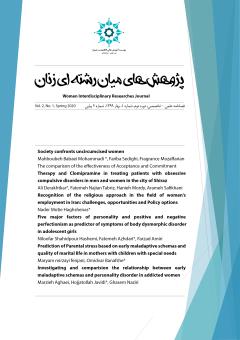Investigating and comparision the relationship between early maladaptive schemas and personality disorder in addicted women
Subject Areas : Other related topicsMarzieh Aghaii 1 , Hojatollah Javidi 2 * , Ghasem Naziri 3
1 - Master of Psychology, Department of Psychology, Islamic Azad University, Marvdasht Branch, Marvdasht, Iran
2 - Assistant Professor, Department of Psychology, Islamic Azad University, Marvdasht Branch, Marvdasht, Iran
3 - PhD in Clinical Psychology, Assistant Professor, Department of Psychology, Shiraz Branch, Islamic Azad University, Shiraz, Iran
Keywords: Schema, Early maladaptive schemas, Personality disorders, Opioid drugs,
Abstract :
The aim of this study was to investigate the relationship between early maladaptive schemas and characteristics of personality disorders among opioid-dependent women located in Shiraz centers addiction treatment. The research design was correlational. The statistical population of this study consisted of 43 opioid-dependent women located in Shiraz addiction treatment centers who were selected by available sampling method andanswered the Young Schema Questionnaire (1988) and Millon Clinical Multi-Axis Questionnai (1987) and analyzed with Pearson correlation coefficient, t-test for dependent groups and multivariate regression of the input model. The present study has 2 research questions about the relationship between early maladaptive schemas and characteristics of personality disorders, differences in early maladaptive schemas and characteristics of personality disorders among women. The results showed that there is a significant correlation between early maladaptive schemas and the characteristics of personality disorders. The results of multivariate regression of the entry model also showed that schemas are able to predict the characteristics of personality disorders and also about the differences in characteristics of personality disorders among addicted women, only antisocial personality disorder and obsessive-compulsive disorder were significant.
1- آبادینسکی، ه. (1384). مواد مخدر (نگاهی اجمالی). ترجمه زکریایی، م.، و کریمی، ج. انتشارات جامعه وفرهنگ.
2- برنا، م.، حميد، ن.، و حياتي، د. (1395). نقش پيش¬بيني كنندگي ويژگيهاي شخصيت، راهبردهاي شناختي تنظيم هيجان، سبك¬هاي دلبستگي و سيستم¬هاي مغزي- رفتاري در آمادگي فعال و غيرفعال به اعتياد و تکانشگري. فصلنامه اعتياد پژوهي، 10(37)، ص 174-151.
3- بنفشه، ح.، مصداقی¬نیا، ا.، قریشی، ف.، گیلاسی، ح.، کاشانی، ز.، غلامی، م.، و قادری، ا. (1397). بررسي الگوي مصرف و علل گرايش به اعتياد در زنان تحت درمان نگهدارنده با متادون شهرستان كاشان طي سال 1396. دو ماهنامه علمي– پژوهشي فيض، 22(5)، 538-532.
4- تکلوی، س.، و رمضانی، م. (1398). مقايسه شكست عاطفي و صفات سه¬گانه تار يک شخ صيت در زنان با و بدون آمادگي به اعتيا د. فصلنامه اعتياد پژوهي سوءمصرف مواد، 13(53)، 300-285.
5- حجت، ک.، وحیدی، گ.، حمیدی، م.، اکابری، آ.، کاظمی، س.، نوروزی خلیلی، م.، شکاری، س.، و محمدی، ف. (1392). مقایسه خصوصیات شخصیتی و باورهاي غیر منطقی در زنان مصرف کننده مواد مخدر سنتی و زنانمصرف کننده مواد مخدر صنعتی. مجله دانشگاه علوم پزشکی خراسان شمالی، 5(2)، 329-323.
6- خواجه موگهی، ن. ( 1372). «آماده¬سازی مقدماتی فرم فارسی پرسش¬نامه چند محوری بالینی میلون -2». پایان¬نامه کارشناسی ارشد: انستیتوروانپزشکی تهران.
7- لطفی، ر. (1385). «مقایسه طرحواره¬های ناسازگار افراد سالم و افراد مبتلا به اختلالات شخصیت دسته B.» پایان¬نامه کارشناسی ارشد، دانشگاه اصفهان.
8- موسوي نسب، م.، شمس¬الديني، ل.، و منصوري، ز. (1394). بررسي نقش واسطه¬اي رضايت از زندگي در رابطه بين راهبردهاي مقابله با استرس و نگرش به اعتياد. فصلنامه اعتياد¬پژوهي، 3(9)، 171-155.
9- Brady, J., Iwamoto, D.K., Grivel, M., Kaya, A.,& Clinton, L.(2016). A systematic review of the salient role of feminine norms on substance use among women. Addictive Behaviors,62,83-90.
10- Braithwaite, S. R., Mitchell, C. M., Selby, E. A., & Fincham, F. D. (2016). "Trait forgiveness and enduring vulnerabilities: Neuroticism and catastrophizing influence relationship satisfaction via less forgiveness". Personality and Individual Differences, 94: 237–246.
11- Castille, K., Prout, M., Marczyk, G., & Shmidheiser, M. (2007). The early maladaptive schemas of self-mutilators: Implications for therapy. Journal of Cognitive Psychotherapy, 21(1), 58..
12- Choca, J. P., & Denburg, E. J.V. (1997). Interpretive guide to the millon clinical multiaxial Inventory. 2 nded. American Psychological Association. Washington. Dc. 54(2), 887-1112
13- Dasgupta, A. (2017). Alcohol, Drugs, Genes and the Clinical Laboratory: An overview for healthcare and safety professionals (pp. 89-105). Academic Press.
14- Gilbert, C.L. (2013). Marital quality in black and white marriages. Journal of Family Issues, 16(4), 431-441.
15- Jordan, A. H., Monin, B., Dweck, C. S., Lovett, B. J., John, O. P., & Gross, J. J. (2011). Misery has more company than people think: Underestimating the prevalence of others’ negative emotions. Personality and Social Psychology Bulletin, 37(1), 120-135.
16- Khosravani, V., Seidisarouei, M., & Alvani, A. (2016). Early maladaptive schemas, behavioral inhibition system, behavioral approach system, and defense styles in natural drug abusers. Polish Annals of Medicine, 23(1), 6-14.
17- Levandowski, M. L., Tractenberg, S. G., de Azeredo, L. A., De Nardi, T., Rovaris, D. L., Bau, C. H., ... & Grassi-Oliveira, R. (2016). Crack cocaine addiction, early life stress and accelerated cellular aging among women. Progress in neuro-psychopharmacology and biological psychiatry, 71, 83-89..
18- Lombard, S., Pullen, D. L., & Swabey, K. (2017). Conceptualizing trauma for children of drug addicted mothers: A developmental mapping. Journal of Trauma & Treatment, 6(1), 1-4..
19- Pereira-Morales, A. J., Adan, A., Lopez-Leon, S., & Forero, D. A. (2018). Personality traits and health-related quality of life: the mediator role of coping strategies and psychological distress. Annals of general psychiatry, 17(1), 1-9..
20- Schmidt, N. B., Joiner, T.E., Young, J.E., & Telch,M.J.(1995). The schema Questionnaire: Investigation of psychometric properties and the hierarchical structure of a measure of maladaptive schemata. Cognitive Therapy and Research, 19(3), 295-321.
21- Terracciano, A., & Costa Jr, P. T. (2004). Smoking and the Five‐Factor Model of personality. Addiction, 99(4), 472-481.
22- Thimm JC. (2010). Personality and early aladaptive schemas: A five-factor model perspective. J Behav Ther Exper Psychiat; 41: 373-80.
23- Young, J. E., & Brown, G. (2005). Young Schema Questionnaire. Short Form, Version 3, from New York: Schema Therapy Institute.

